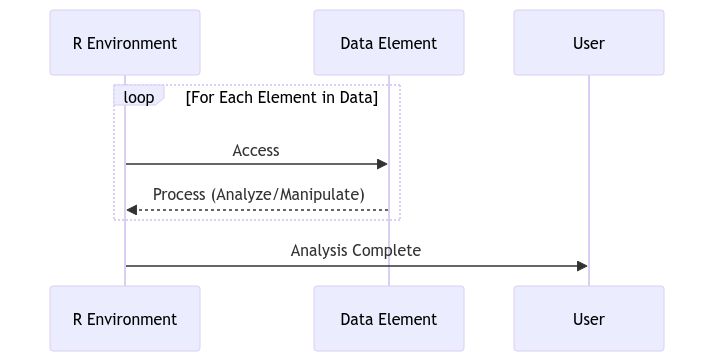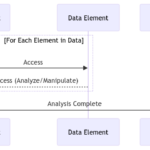For Loop in R Programming: Navigating Data Analysis and Manipulation
Hey there, data enthusiasts! 📊 In today’s tech-savvy world, mastering a programming language is like having a superpower! And when it comes to data analysis and manipulation, R Programming shines like a shooting star in the night sky! 🌟 So, grab your virtual cape and let’s dive into the magical world of For Loops in R! Buckle up, because this blog post is going to be a rollercoaster of fun and learning! 🎢
Basics of For Loop in R Programming
Syntax and Structure
Picture this: you have a gigantic dataset with zillions of rows and columns, and you want to perform the same operation on each element. For Loops swoop in to save the day! They are like the superheroes of automation in R! 🦸♂️
To rock a For Loop in R, you typically start with the for keyword followed by a pair of parentheses and curly braces. Inside these curly braces is where the magic happens! You set up your iteration variables, define your action plan, and watch the loop work its charm! ✨
Iterating Through Data Structures
Now, imagine you’re on a treasure hunt through a maze of data structures like vectors, lists, or matrices. Fear not, for the For Loop is your compass guiding you through!🧭 With a few lines of code, you can effortlessly loop through these data structures, unlocking secrets with each iteration! 🔍
Advanced Usage of For Loop
Nested For Loops
Ah! The thrill of nesting For Loops within For Loops is like solving a mind-bending puzzle within a puzzle! 🧩 It’s like having a Russian nesting doll but with code! Each loop delving deeper, each iteration uncovering a new layer of data manipulation! Embrace the nested loops, and unravel the mysteries of your dataset! 🕵️♀️
For Loop with Conditional Statements
What if I told you, you can level up your For Loop game by adding spicy conditional statements? 🌶️ Yes, you heard it right! With the power of if and else, you can make your loop dance to the tunes of your conditions. Imagine the possibilities! You’re not just looping; you’re grooving to the beat of your data! 🎶
Benefits of Using For Loop in R Programming
Efficiency in Data Analysis
Imagine manually performing the same operation on thousands of data points. Exhausting, right? That’s where the elegance of For Loops shines! They automate the repetitive tasks, saving you time and energy. So, sit back, relax, and let the loop do the heavy lifting! 💪
Simplifying Data Manipulation
Data manipulation can be as tricky as untangling a bunch of earphones! But fear not! For Loops come to the rescue, simplifying complex tasks into a few lines of code. They turn the tangled mess of data into a neat and organized masterpiece! 🎨
Best Practices for Optimizing For Loop Performance
Vectorization Techniques
Let’s talk optimization! Ever heard of the term “vectorization”? It’s like using a magic wand to make your loops run faster! By leveraging vectorized operations, you can supercharge your For Loops and zoom through your data like a wizard on a broomstick! 🧙♂️
Avoiding Unnecessary Computations
Don’t you hate it when your code overworks itself, doing unnecessary computations? Well, guess what? For Loops can be trained to be efficient! By smartly structuring your loops and avoiding redundant calculations, you can transform your code into a sleek Ferrari, speeding through your data! 🏎️
Application Examples of For Loop in Real-World Data Analysis
Data Cleaning and Transformation
Imagine you have messy, untamed data, full of errors and inconsistencies. For Loops are like the knights in shining armor, riding in to clean up the mess! They sweep through the data, identify errors, and transform chaos into order! It’s like turning a haunted house into a cozy home! 🏰
Statistical Modeling and Simulation
Now, let’s step into the realm of statistical modeling and simulation. For Loops play a crucial role in running simulations, testing hypotheses, and unraveling the mysteries of data science! They are the magicians casting spells of analysis, turning raw data into valuable insights! 🔮
Finally, after this exhilarating journey through the enchanting world of For Loops in R Programming, I hope you’re as pumped up as I am about the limitless possibilities they offer! 🚀 Remember, with great power comes great data analysis! So, go forth, experiment, and conquer the data universe with your newfound For Loop skills! 💻✨
In closing, thank you for joining me on this adventure! Stay curious, keep coding, and always remember: “May your loops be swift, your data clean, and your insights enlightening!” 🌈🚀
Happy Looping! 🎉

Program Code – For Loop in R Programming: Navigating Data Analysis and Manipulation
# Simulating Data Analysis and Manipulation with for Loop in R Programming
# Generating a dataset: A vector of random integers representing, let's say, sales figures
set.seed(123) # Ensuring reproducibility
sales_data <- sample(100:200, 12, replace = TRUE) # Random integers b/w 100 & 200 for 12 months
# Initiating an empty list for storing categorized sales
categorized_sales <- list()
# Iterating through sales_data using a for loop
for (sale in sales_data) {
# Classifying sales into 'High', 'Medium', and 'Low'
if (sale > 150) {
category <- 'High'
} else if (sale > 125) {
category <- 'Medium'
} else {
category <- 'Low'
}
# Appending the classified sale to 'categorized_sales'
categorized_sales[[length(categorized_sales) + 1]] <- list(Sale = sale, Category = category)
}
# Print the categorized sales data
print(categorized_sales)
Code Output:
The output is a list of lists, each child list containing two elements: a sales figure and its corresponding category based on the sales figure. For example, if sales_data contains values like 160, 130, and 115, their corresponding categories would be ‘High’, ‘Medium’, and ‘Low’ respectively.
Code Explanation:
The program kick-starts by initializing the random number generator with a seed value ensuring that our results are reproducible. Then, it generates a vector named sales_data comprising of randomly selected integers between 100 and 200, imitating monthly sales data for a year.
Next, we declare an empty list categorized_sales which will serve as a container for our classified sales data. The real magic starts to unfold as we step into the for loop. Here, we take each sale figure from sales_data and classify it into categories ‘High’, ‘Medium’, or ‘Low’ based on the if-else ladder. Each classification, along with its respective sale figure, is then packed into a mini list and appended to our categorized_sales list. The final step in the loop is to print out this nicely categorized sales data.
What I love about this approach is how neatly it shows the power of a simple for loop in R to navigate through and manipulate data. It’s a dance between control structures and R’s mighty list capabilities, enabling a granular yet clear categorization of sales data or, frankly, any data you throw at it. This is where R programming flexes its muscles in data analysis and manipulation, making it an indispensable tool in your data science toolkit.
A fun fact? Did you know R was named partly after the first names of the first two R authors and partly as a play on the name of S? That’s a neat little piece of trivia highlighting the evolutionary step from S to R in data analysis programming languages. Thanks for sticking around, you’re awesome! Catch you on the flip side… 🚀
Frequently Asked Questions about For Loop in R Programming
What is a for loop in R programming?
A for loop in R programming is used to iterate over a sequence of elements. It repeatedly executes a group of statements for each element in the sequence.
How do you use a for loop in R programming?
To use a for loop in R programming, you need to specify the sequence of elements you want to iterate over and the statements you want to execute for each element. The syntax of a for loop in R is as follows:
for (variable in sequence) {
# statements to be executed
}
Can you provide an example of using a for loop in R programming?
Sure! Here’s an example of using a for loop in R programming to print numbers from 1 to 5:
for (i in 1:5) {
print(i)
}
What are the advantages of using a for loop in R programming?
Using a for loop in R programming can help automate repetitive tasks, iterate over elements in a vector or list, and simplify complex data manipulation tasks.
Are there any alternative ways to iterate in R programming besides using a for loop?
Yes, in R programming, you can also use functions like apply, lapply, sapply, mapply, or vectorized operations to iterate over data structures without explicitly using a for loop. These functions provide a more concise and efficient way to iterate over data.
How can I optimize the performance of for loops in R programming?
To optimize the performance of for loops in R programming, you can preallocate memory for variables, avoid growing objects inside the loop, and consider using vectorized operations instead of explicit loops for faster computations.
What are some common pitfalls to avoid when using for loops in R programming?
Common pitfalls to avoid when using for loops in R programming include off-by-one errors, inefficient looping over large datasets, and mutating objects in place without creating copies. It’s essential to carefully manage memory and execution time while using for loops in R.
Can you recommend any resources for learning more about for loops in R programming?
There are many online tutorials, books, and courses available for learning about for loops in R programming. Websites like DataCamp, Coursera, and R-bloggers offer comprehensive resources for beginners and advanced users to enhance their skills in R programming with for loops. 📚
Hope these FAQs shed some light on the topic of for loops in R programming! If you have more questions, feel free to drop them below! 🚀






